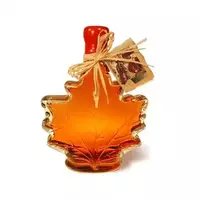Maple syrup

Surely, for the first time, many of us learned about a product like maple syrup solely through cinema, in particular Hollywood. After all, if the heroes of the films order pancakes or pancakes, then without fail, watered with maple syrup.
Meanwhile, maple syrup is thickened during evaporation with juice of deciduous trees that belong to the Sapindov family: sugar maple (resembling black maple) or red maple. These trees grow in North America, reaching 30 meters in height with a diameter of more than one meter.
Notably, North American Indians used sweet maple juice long before Europeans discovered America. It mainly acted as a base for making syrup, sugar and refreshing drinks. The first European immigrants also appreciated the taste and beneficial properties of maple syrup, adopting the method of extraction and methods of processing juice from the natives.
Most maple juice production is developed in Canada, where sugar maple is quite widespread. In this country, it is even a national symbol: a stylized image of a maple leaf is placed on the state flag. The main production of maple syrup is concentrated in Quebec - the province of Canada.
Maple syrup itself is a transparent or translucent fragrant, thick, viscous liquid, which in consistency resembles fresh natural honey of various amber shades. The most fragrant is rightfully considered dark amber maple syrup, which is collected at the end of the season. The calorie content of maple syrup is 261 kcal per hundred grams.
In national cuisines in Canada and America, maple syrup is used very widely. It is customary to serve it to fritters, pancakes, ice cream, waffles and other delicious dishes. In addition, it is often added during the preparation of meat and vegetable dishes, sauces, desserts and pastries. In confectionery, maple syrup is considered an excellent natural sugar substitute.
Speaking of maple syrup, one cannot fail to mention the traditional Quebec holiday "Sugar Hut, " which takes place during the juice season. It is held in the forest, not far from the plots, where maple juice is collected. Traditional dishes with fresh maple syrup are served to the table: omelette, thickly watered syrup, syrup-baked ham, oven-baked beans with brisket and ham under maple sauce, and beer, which is brewed all from the same maple juice.
Maple syrup composition
The composition of maple syrup implies the use of exclusively natural raw materials, during the treatment of which chemical components are not used. In addition, this product does not contain preservatives or artificial fillers.
The chemical composition of maple syrup includes a considerable number of minerals (iron, potassium, calcium, zinc, phosphorus and others), as well as a complex of vitamins B. Polyphenols and many other antioxidants are present in this natural product, which help to overcome not only cardiovascular, but even cancer.
The benefits of maple syrup
The benefits of maple syrup are due to the ability to act as a natural immunostimulant, the main effect of which is to prevent the development of atherosclerosis, increase potency, and reduce the risk of diabetes. This sweet treat is included in foods that are recommended for a healthy diet and is a great alternative to sugar, jams and jam.
However, despite the obvious benefit of maple syrup, it is recommended to consume it in moderation due to its sufficiently high glucose content.
261 kCal maple syrup
Energy value of maple syrup (Ratio of proteins, fats, carbohydrates - ju):
Proteins: 0 g (~ 0 kCal)
Fats: 0 g (~ 0 kCal)
Carbohydrates: 67g (~ 268kCal)
Energy ratio (bj | y): 0% | 0% | 103%
 Español
Español Français
Français Português
Português Русский
Русский 简体中文
简体中文 繁體中文
繁體中文 日本語
日本語 한국어
한국어 العربية
العربية Türkçe
Türkçe Қазақ
Қазақ Deutsch
Deutsch Italiano
Italiano Українська
Українська
